A final year project on “Smart Plug & Smart Distribution Board” submitted by Geoji George (from A.P.J Abdul Kalam Technological University) to extrudesign.com.

Abstract
There are numerous accidents due to electrical faults or failures occurring every day in the world. Quick response time would help to reduce the casualties and heavy losses from these accidents. So we are proposing a system that would identify or detect any faults in the electrical system and alerts the user in real-time. The system also gives information about the real-time power factor, energy consumption, etc. Proper power factor is an important aspect in an electrical system as it reduces the load on the electrical distribution system, increases energy efficiency, reduces electricity costs and also decreases the likelihood of instability and failure of equipment.
The various sensors like a current sensor, voltage sensor, power sensor will be connected to the distribution board. The sensors read data and send it to a raspberry pi based server using an esp8266 based microcontroller. The raspberry pi processes this data using some algorithms and sends the results to a cloud platform like firebase which is being integrated with a cross-platform application. There will be a smart plug which can be used to control and monitor individual appliances using the app. The app also alerts about bad weather conditions like thunderstorms, lighting, etc which can cause damage to the electrical appliances so the user can remotely switch off the appliances to protect them.
Keywords: Energy consumption, current sensor, voltage sensor, raspberry pi, smart plug.
I. Introduction
Power is the soul of the world which is relevant to electricity and “ELECTRICITY” is the word that now rules the world. So, proper utilization of this commodity is of immense importance to us. Conventional systems require an individual and agent to physically come and take down the readings and report to the household or office the amount one has to pay. Because of this many complaints are arising against KSEB from consumers due to their huge and improper bill amounts. So, a user-friendly energy consumption monitoring and warning system could help to reduce unwanted energy consumption and reduce disputes regarding electricity bills to an extent. Power factor detection and correction is an important aspect to be considered as a change in power factor can lead to huge fines from KSEB. Proper power factor increases energy efficiency, reduces electricity costs and also decreases the likelihood of instability and failure of equipment. There are numerous accidents that are occurring due to the faults in Electrical systems. A proper alerting or warning system is not present currently.
The main theme of the work is to develop a Smart Distribution Board coupled with various sensors and integrated with a cross-platform application that could alert users about faults in the electrical system, gives their real-time energy consumption, gives necessary alerts and warnings etc. and a system to automatically correct the power factor.
A) Problem statement
Most of the equipment in the Industries, as well as domestic platforms, are highly sensitive to electrical faults and it will cost a fortune to replace the equipment. A proper system is required which acts as an additional layer of protection to the equipment by determining whether an electric surge early and gives warning through handheld devices, thus minimizing the risk of catastrophe. Users should be aware of their Energy Consumption in real-time so they will be prompt to use electricity judiciously and this will help to reduce the disputes from consumers against KSEB on huge and improper electricity bill amounts.
B) Energy Consumption Monitoring and Warning System
With the help of a module (main energy meter) using various sensors, consumers would get real-time data about their energy consumption. It also notifies the consumer if there are any abnormalities in the system
C) Voltage Fluctuation Warning System
The voltage monitoring unit will detect if there is any voltage fluctuation and notifies the user. It can even take actions like disconnecting the appliance from the circuit (or turn of the main mcb) but it’s a strictly optional and scalable feature.
D) Alerting System Based on Harsh Weather Condition
This smart feature is an asset to our project. It notifies the user to take precautions for the harsh weather conditions reported by trustworthy weather forecasting companies like Accuweather etc.
E) Smart plug
Smart Plug is a device that helps us to control the appliance wirelessly through the cross-platform app. We can even monitor the Current, Voltage consumption of the Appliance The smart plug is used to control and monitor appliances remotely. In the event of any faults or weather surges, we can isolate the appliance using smart plug. The smart plug consists of a relay module, current sensor, power converter and a NodeMCU module. The data is sent to the firebase cloud. The users can control and monitor the smart plug using the mobile app.
F) Cross-platform application
Cross-platform application “smart_db” is the application that we have developed to help the user track Real-Time Energy Consumption and Control the Appliances efficiently. It helps the consumer aware of Energy usage and bills. The app will alert the user about any weather surges like Thunderstorms, lightning, etc so they can act accordingly. It also gives users alerts about scheduled power outages, real-time energy bills etc. The app helps userss with power factor correction. If a lagging power factor is detected, the user will be alerted in real-time so he/she can switch off the power factor reducing appliance remotely using the smart plug.
II. Literature Review
A) IoT Based Smart Home & Short Circuit Protection & Detection System
This paper proposes to use IoT so as to handle home appliances, and automate the home system through the internet and as well as the system also protects the appliances under short circuit conditions. This IoT based Home Automation system aims to control all the devices of your smart home through internet protocols or cloud-based computing. This is done using Node MCU for transferring data over the cloud, an MCB to switch the circuit to protect equipment’s and an LCD panel to visualize updates.
B) A Smart Distribution Box Controller For Customer- Based Operations
In this paper, the design of a smart distribution box controller is proposed in order to assist consumers to control or regulate energy consumption during off-peak and peak times. The designed smart system assigns various loads to different priorities and removes non-priority loads during peak times. It also monitors the voltage, frequency, current and sunlight. Results show 25% reduction of energy consumption and cost savings of up to 40 % are possible with the use of a smart distribution box.
C) Arduino Based Single Phase Fault Detection System Using IoT
This paper deals with a new method of single-phase fault detection and also switching based on Arduino displayed over the internet. Current transformers are used to detect current levels, this output current will be given to 1 to 5 converter units so as to make it readable in terms of voltage. This voltage is fed into adc pin of Arduino which converts it into digital and take appropriate action if any fault condition (sc or oc) occurs. The fault is displayed on the LCD display and on The ACS712 Current Sensors offered on the internet are designed to be easily used with microcontrollers like the Arduino. These sensors are based on the Allegro ACS712ELC chip. These current sensors are offered with full-scale values of 5A, 20A and 30A. The basic functional operation of each of these devices is identical. The only difference is with the scale factor at the output as detailed below. LEDs. Relay driver and relay circuit are used to switch single phase load of city electricity distribution system on another ok phase to provide end-user an uninterrupted power supply. A fault clearing switch is provided to manually tell the system about fault clearing.
D) Automatic Power Factor Correction Unit Using Arduino
This paper provides one of the techniques used to overcome power losses due to low power factors associated with common household and small industrial units. In this paper, AC load voltage and the current were measured by sampling rectified sine waves. For rectification, a precision rectifier was designed and applied using op-amp. The sampling was started when the input wave crosses the horizontal axis in both cases of voltage and current. Moreover, based on this analysis, a corrective algorithm was established to achieve power factors close to unity.
III. Components of Smart Distribution Board & Smart Plug
1. Raspberry Pi
Raspberry Pi is a series of small single-board computers developed in the United Kingdom by the Raspberry Pi Foundation in association with Broadcom. This Raspberry Pi 4 is integrated with a 64-bit quad-core Cortex- A72 ARM v8, Broadcom BCM2711 and runs at a speed of 1.5GHz The new Raspberry Pi product is equipped with Bluetooth 5.0, BLE, gigabit ethernet and has 802.11ac wireless at 2.4GHz and 5GHz. It provides faster data transfer with two USB 3.0 ports, two USB 2.0 ports, micro SD slot for data storage and loading operating systems The Raspberry Pi 4 has 2 micro HDMI ports (supports 4k@60p), 2 lane MIPI DSI display port, 2 lane MIPI CSI camera port and 4-pole stereo audio and composite video port.
2. Node MCU
Node MCU is an open-source firmware for which open-source prototyping board designs are available. The name “NodeMCU” combines “node” and “MCU” (micro-controller unit).[8] The term “NodeMCU” strictly speaking refers to the firmware rather than the associated development kits. Both the firmware and prototyping board designs are open source. The firmware uses the Lua scripting language. The firmware is based on the eLua project and built on the Espressif Non-OS SDK for ESP8266. It uses many open source projects, such as lua- cjson and SPIFFS.
3. Voltage Sensor
ZMPT101B AC Single Phase voltage sensor module is based on a high precision ZMPT101B voltage Transformer. This is an ideal choice to measure the AC voltage using Arduino/ESP8266/Raspberry Pi like an open-source platform. In many electrical projects, engineers directly deal with measurements with few basic requirements like High galvanic isolation, Wide Range, High accuracy, Good Consistency.
4. Current Sensor
The ACS712 Current Sensors offered on the internet are designed to be easily used with microcontrollers like the Arduino. These sensors are based on the Allegro ACS712ELC chip. These current sensors are offered with full scale values of 5A, 20A and 30A.The basic functional operation of each of these devices is identical. The only difference is with the scale factor at the output as detailed below.
5. Relay Module
Relays are electromechanical devices that use an electromagnet to operate a pair of movable contacts from an open position to a closed position. Here relay switch is used to disconnect load from meter when recharge balance becomes zero.
6. Power Monitor
This PZEM-004T Multi-function AC Power Monitor is very popular in electrical consumption measurement projects. It is capable of measuring four interrelated electrical variables as voltage, current, power, and energy. The unit easily interfaces with Arduino and other hardware using the code library.
7. Hi Link Hlk Pm01 5v/3w Switch Power Supply Module
HLK-PM01 5V/3W Switch Power Supply Module is a plastic enclosed PCB mounted isolated switching step-down power supply module. It can supply 5V DC from120V AC – 230V AC and has a power rating of 3 Watt. This makes it perfect for our project that needs a 5 volt supply from mains. There are many advantages for these modules, such as low-temperature rise, low power, high efficiency, high reliability, high-security isolation etc.
8. ESP32
ESP32 is a low-power system on a chip microcontroller with integrated Wi-Fi and dual-mode Bluetooth. The ESP32 series employs a Tensilica Xtensa LX6 microprocessor in both dual-core and single-core variations and includes built-in antenna switches, RF balun, power amplifier, low-noise receive amplifier, filters, and power-management modules] It is a successor to the ESP8266 microcontroller.
9. DHT11
The DHT11 is a Temperature and humidity sensor. The sensor comes with a dedicated NTC to measure temperature and an 8-bit microcontroller to output the values of temperature and humidity as serial data. The sensor is also factory calibrated and hence easy to interface with other microcontrollers.
10. Mq2 Flammable Gas And Smoke Sensor Module
This is a semiconductor gas sensor Module with analogue and digital output. This module uses MQ2 Smoke & Flammable gas sensor as a gas sensing element. It requires no external components just plug in Vcc & ground pins and you are ready to go. For Digital output, the threshold value can be easily set by an onboard potentiometer. Using this module you can easily interface MQ2 Smoke & Combustible gas Sensor to any Microcontroller, Arduino or even Raspberry Pi. Since this Gas Sensor module is sensitive to smoke it can be used for fire detection. MQ2 Gas Sensor is also sensitive to flammable/combustible gasses like LPG, Propane & Hydrogen.
11. Ky-026 Flame Sensor Module
KY-026 Flame Sensor Module for Arduino detects infrared light emitted by fire. The module has both digital and analog outputs and a potentiometer to adjust the sensitivity. Commonly used in fire detection systems. The KY-026 consist of a 5mm infra-red receiver LED, a LM393 dual differential comparator a 3296W trimmer potentiometer, six resistors and two indicator LEDs. The board features an analog and a digital output.
IV. Communication Protocol For Software Implementation
MQTT is a publish-subscribe protocol used to read IoT data. The information is given out in an optimum way. It is extremely lightweight and enhances scalability. As it is a publish/subscribe protocol it gathers data with fewer bandwidths in contrast to other protocols. It allows communication between any two devices. Devices can subscribe to any specific subject. Any client who has subscribed gets the message forwarded by the broker when the message is published by the other client. Monitoring of large quantity of data is possible. It also helps in remote monitoring and is bidirectional.
MQTT dashboard application help in obtaining real-time values and uses MQTT protocol. Numerical values of water quantity parameters like pH and turbidity can be acquired progressively in cell phones. So, the operator does not want to check these values by going to the site of the pumping station. The accurate values will be obtained on his mobile phone so he can check the values whenever needed.
V. Block Diagram
This is the block diagram of the Smart Distribution Box. Here, the Distribution board collects data from the Energy Consumption Monitoring System, Power Factor Detection System, Current Detection System. The collected data are processed inside the Smart Distribution Board unit and transfer these essential data over the cloud base. The cloud base is created using Raspberry pi which helps to access the unit even from a distant place. And these data can be access and control through the cross-platform app, Smart plug is also embedded with the cloud to enable home automation systems. So, the user can monitor and control the unit using the cross-platform app.
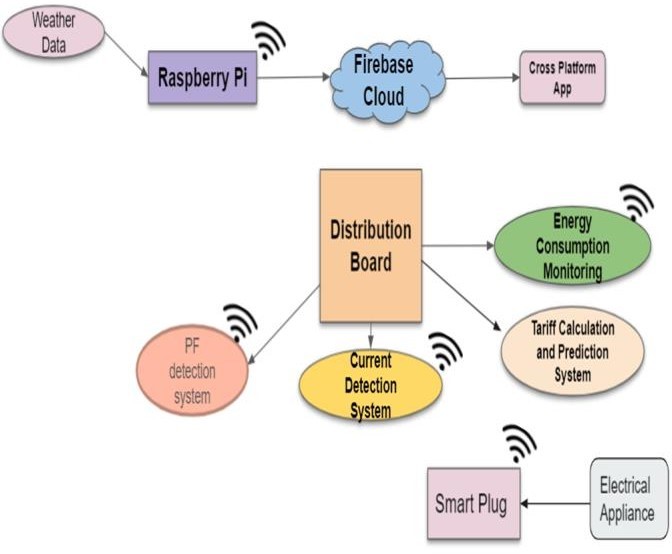
VI. Smart Distribution Board
Smart Distribution Board is an IOT based device that gives you the ability to have real-time electrical audits that are reported to the cloud using Raspberry Pi.
Various sensors and microcontrollers are employed in the distribution board for real-time monitoring and processing. Between Isolator and ELCB our smart energy meter is deployed for monitoring real-time energy consumption, power, voltage, current, frequency and power factor. After the ELCB lies the MCB’s to each sub-circuits. The output phase line from the MCB is fed to current sensors to monitor real-time current.
There will be a smoke sensor, flame sensor, DHT sensor for additional protection of the Distribution Board. The Energy Metering Module is connected to Raspberry Pi wirelessly through MQTT Protocol. Other sensors are directly connected to the GPIO pins of the Raspberry Pi.
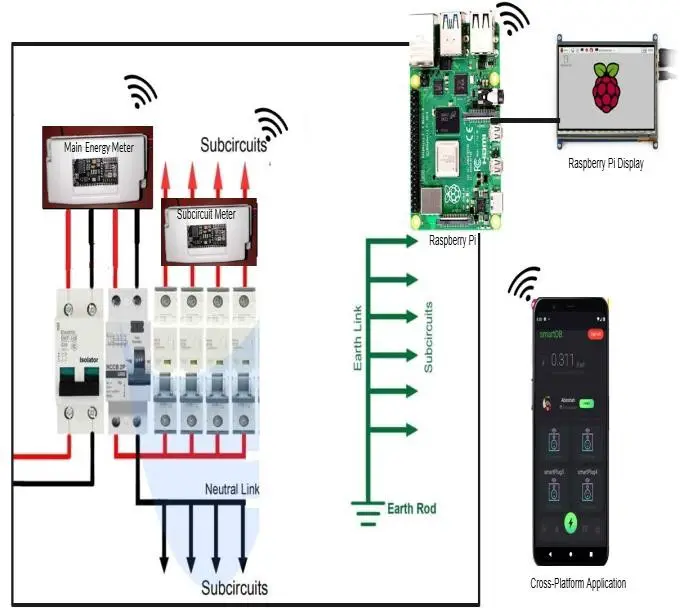
VII. Smart Energy Meter
The Smart Energy Meter provides real-time monitoring of Voltage, Current, Power, Energy, Frequency, Power Factor. PZEM-004T-100A is used for the metering application. The data from the smart meter is fed to an ESP8266 module which is wirelessly connected to Raspberry Pi using MQTT Protocol. The Raspberry Pi receives the data and processes the data. The processed data is sent to Firebase Cloud Database which is being integrated into a cross-platform application.
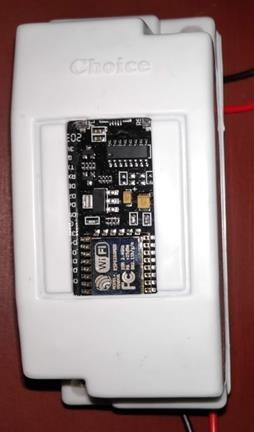
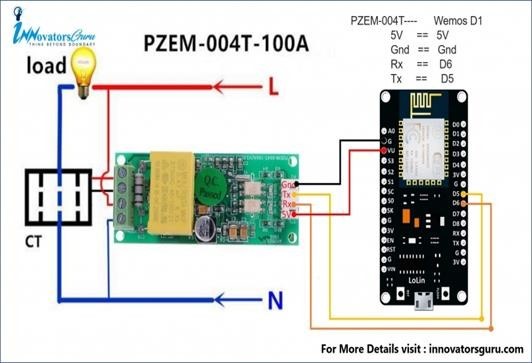
VIII. Smart Plug
The smart plug is used to control and monitor appliances remotely. In the event of any faults or weather surges, we can isolate the appliance using a smart plug.
The smart plug consists of a relay module, current sensor, power converter and a NodeMCU module. The data is sent to the firebase cloud. The users can control and monitor the smart plug using the mobile app.
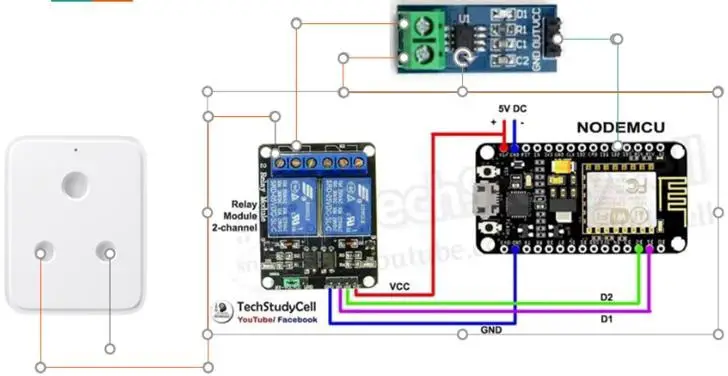
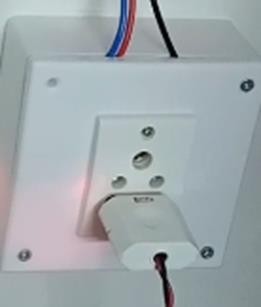
IX. Cross-Platform Application
A) Login Page
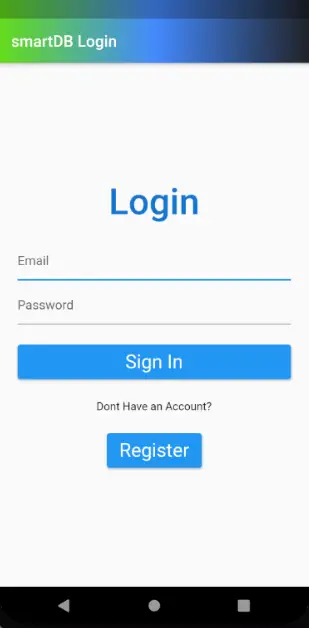
This is the first window we can see when launching the application. This page helps the user to log in to the existing user account using Firebase Authentication. The user can change the password if he forgets. Or else if he is a noob, he can Create an Account by pressing the Register button.
B) Registration Page
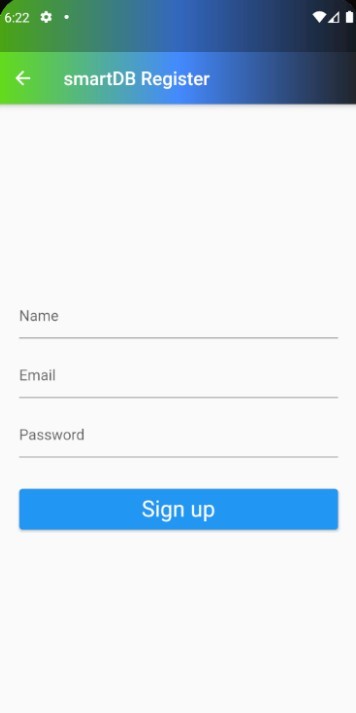
This page helps the user to create a new account by entering his Name, Email ID and a Secure Password. An OTP will be sent to the Email ID in order to verify the authenticity of the user. The User will automatically log in after successfully registering the account.
C) Home Page
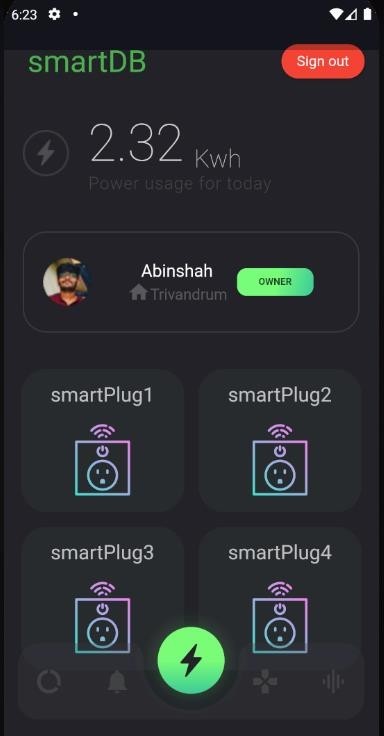
This is the Home Page of our app. Real-time power usage is displayed on the top. Also provided the switches for Smart Plug. The user can control the Appliance anytime using the app. The user name is displayed below the Real-time power usage meter. The user can navigate to various Sub Sections like Usage Status, Alerts, SmartDB Status and Usage Report respectively through the bottom panel.
D) Usage Status
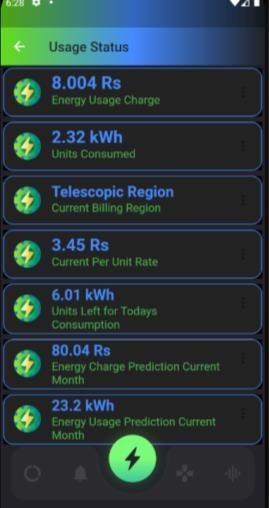
The Usage Status gives an overview about the Consumed Units, Current per unit rate, Units left, Energy charge prediction current months, Energy usage prediction etc.
E) Alerts
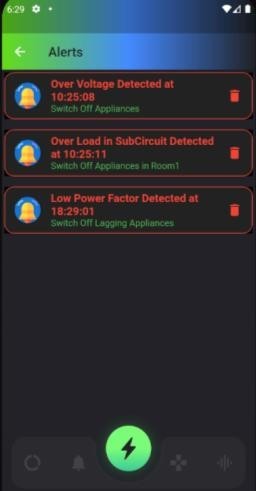
We can access the notifications/alerts from this section of the app. The user will be notified if there is any Over Voltage or Low Power Factor detected by the sensor units mounted in the Smart Distribution Board. Chances of occurring any weather surges like Thunderstorm, lightning, etc will also be notified so they can act accordingly. It also gives user alert about scheduled power outages, real-time energy bill etc
F) SmartDB Status
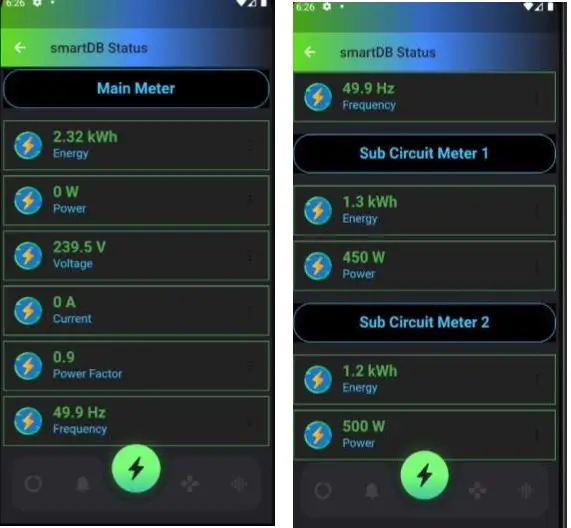
The Main Energy Meter and the Sub Circuit Meter can be monitored using the SmartDB Status subsection. Energy, Power, Voltage, Current Power Factor, Frequency of the Main Meter can be monitored using this feature. We can also monitor the Energy and Power usage of the Sub Circuit Meter that is connected with the Smart Distribution Board.
G) Usage Report
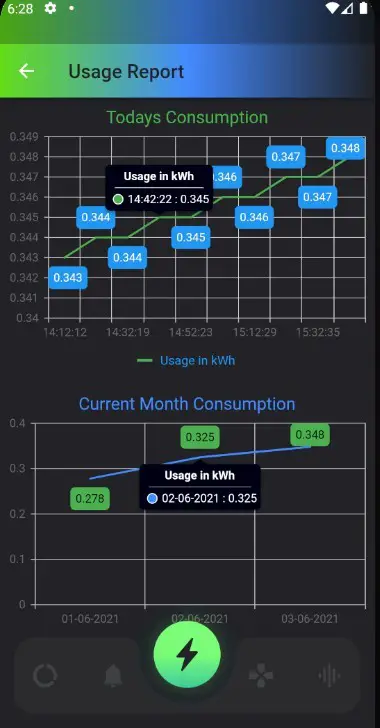
X. Estimate Cost
| Components | Cost |
| Raspberry Pi 4 Model B | 5000 |
| Node MCU (4 NOS) | 1400 |
| Current Sensor- ACS712 – 30A (4 NOS) | 480 |
| Voltage Sensor- ZMPT101B (4 NOS) | 760 |
| Relay Module (4 NOS) | 260 |
| PZEM-004T AC Multi- function Electric Energy Metering Power Monitor (2 NOS) | 1800 |
| LCD Display | 2000 |
| Total Estimate | 12000 |
XI. Conclusion
Our project titled “Smart Distribution Board” is a major modification of the conventional distribution boards by adding another layer of security and safety. The user will be alerted in real-time using the app if there are any faults like a short circuit, voltage fluctuations, overload, etc so the user can act accordingly and prevent heavy losses to life and properties. The app alerts users in the event of harsh weather conditions like lighting, thunderstorm, etc which is one of the major causes of damaging electrical appliances. Our project also introduces automatic power factor corrections to prevent huge fines from electricity boards and to increase efficiency. Our product makes the user use energy judiciously by providing real-time consumption data to the user and increases the quality of life.
XII. Future Scope
- Energy usage data sharing with KSEB, so they don’t want to come every home to take a reading.
- Implementing artificial intelligence for prediction and analysis.
- New features like online energy bill payment directly through our application
- In build display screen on the module for real-time data statistics for the user.
- Online support feature and feedback system for our app to provide a better experience.
XIII. References
- K.Mukundan, Pranav Bala, Karthikeyan.S, Ranjith Kumar.S, Nagaraj.R,”Automatic Power Factor Correction Unit using Arduino”,International Journal of Innovative Research in Electrical, Electronics, Instrumentation and Control Engineering, vol. 06, no. 04, April 2018.
- Sarang Malusare, Moin Kazi, Mohammad Abrar, Shaikh Shahrukh, Manish Mahale “IoT BASED SMART HOUSE & SHORT CIRCUIT PROTECTION & DETECTION SYSTEM” , International Research Journal of Engineering and Technology, vol. 07, no. 07, July 2020.
- Kanchan D. Sase “Arduino based single phase fault detection system using iot”, International Research Journal of Engineering and Technology, vol. 07, no. 03, March 2020.
- Jabhile Prudence Ngwenya and Pitshou Bokoro,”A smart distribution box controller for customer- based operations”,IEEE PES/IAS Power Africa, 2018
Credit: This project work completed by Geoji George, Abinshah Ameer, Linson S, Sachin P and F.R. Rejish Babu from Electrical and Electronics Engineering, A.P.J Abdul Kalam Technological University Trivandrum, Kerala, India.
Acknowledgement
The authors would like to acknowledge the support from the Department of Electrical and Electronic Engineering, Mar Baselios College of Engineering And Technology, A.P.J Abdul Kalam Technological University, Trivandrum. We would also like to acknowledge Mr Rejish Babu for their guidance.

Hi I want information about this smart distribution board can you please reply me through mail
I have replied on mail
Sir please reply back in mail
Please check your junk mail or spam mail. We have replied multiple times over mail.
Hi,
This is a very interesting project. Thank you for sharing your knowledge. I would like to talk to you about your experience in developing this product. Please do let me know what is the best way to connect.
very creative project
I really loved it
great job, well done !
In fact, we are doing a project similar to it as a final year graduation project but without the smart plug,And your project is one of the projects that I relied on very much.
I’m stuck on some things about the project and I really want the project to work.
Can I get more information about this project Can you help me ?
thank you very much.
well done!
Hello Fathimah,
We have published the project paper as per the student’s request. we do not have any further information.
You can also publish your project paper here!
I like to have a sponsor for my construction company.Donsini construction and projects.Rej:2014/184191/07.
Hello
Glad to see this project and sounds related to my concept. I am looking it to take it on commercial basis on PAN india basis so that we can have all the utilities save on electrocutions and electrical theft so that both the society and utility can be saved, please contact me on my mail